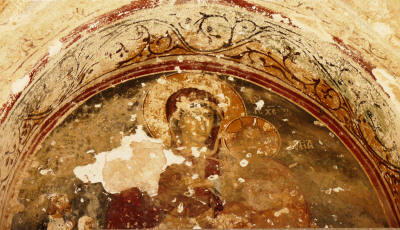Panaya Kanakaria
Boltasli, North Cyprus
 |
| Panaya Kanakaria Church |
Situated on the edge of Boltasli village, the church of Panaya Kanakaria dates back to the early Byzantine period. There is, however, virtually no trace of the original church. What we can see today is from the late 5th century onwards.
The church is cruciform in shape, having been originally built as a colonnaded basilica. It was largely destroyed during the Arab raids of the 700s, and rebuilt. Further restoration was required after an earthquake in 1169, when it took its form as a multi-domed church. The porch was added around 1400, at the same time as the roof was strengthened. The central drummed cupola dates to the 1700s. and was probably added at the same time as a monastery was opened.
 |
| Fresco of the Virgin Mary Above the Entrance |
The apse, which is part of the original church, was adorned with mosaics, believed to have been made around 550, and considered to be some of the most important surviving pieces of early Christian artwork, having escaped the almost total destruction of religious images during the Byzantine Iconoclastic period from 726 to 843 AD. They consisted of the Virgin and Child, Saint James and Saint Andrew, and an Archangel.
Some time after 1979, these mosaics were looted and found their way to America via Munich, along with some other stolen works of art. In a famous court case, they were retrieved and returned to Cyprus, where they are now on display in the Byzantine museum in south Nicosia.
Outside the church, above the porch, there is a fresco of the Virgin Mary, dating to 1779.
The church is usually locked, but the key is held locally, and the church is occasionally open. However, even from the outside it is worth a visit. (And if you're there during the season, pick yourself some delicious figs from the tree growing wild at the entrance.)
See the location on Google maps.
Return to Dipkarpaz index.